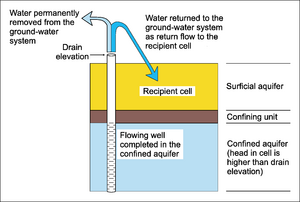GMS:DRT Package: Difference between revisions
From XMS Wiki
Jump to navigationJump to search
No edit summary Tag: Manual revert |
|||
| (2 intermediate revisions by 2 users not shown) | |||
| Line 22: | Line 22: | ||
}}</ref>]] | }}</ref>]] | ||
}} | }} | ||
==Conceptual | ==Conceptual Model== | ||
Drains can be modeled using points, arcs and/or polygons in a [[GMS:MODFLOW Conceptual Model Approach|conceptual model]]. The return cell cannot be specified in the conceptual model. This is because the conceptual model is independent of the grid and, in fact, there may be no grid at all when the conceptual model is defined. When GMS performs the '''Map→MODFLOW''' command, the return cell is always set to be the highest active cell above the drain cell. This can later be changed in the ''Drain Package'' dialog. | Drains can be modeled using points, arcs and/or polygons in a [[GMS:MODFLOW Conceptual Model Approach|conceptual model]]. The return cell cannot be specified in the conceptual model. This is because the conceptual model is independent of the grid and, in fact, there may be no grid at all when the conceptual model is defined. When GMS performs the '''Map→MODFLOW''' command, the return cell is always set to be the highest active cell above the drain cell. This can later be changed in the ''Drain Package'' dialog. | ||

